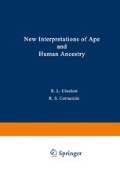Abstract
The analysis of amino acid sequence data by the maximum parsimony method can provide valuable insights into the evolutionary processes which shaped the hominoid radiation and the emergence of Homo. Recent discoveries of hominine and ramapithecine fossils from East Africa and Asia have stimulated reevaluation of the evolutionary history of Anthropoidea, especially of that branch leading to Homo sapiens (Johanson and White, 1979; Greenfield, 1980).
Access this chapter
Tax calculation will be finalised at checkout
Purchases are for personal use only
Preview
Unable to display preview. Download preview PDF.
References
Baba, M. L., Darga, L. L., and Goodman, M. 1979. Immunodiffusion systematics of the primates. Part V. The Platyrrhini. Folia Primatol. 32 (3): 207–238.
Baba, M. L., Darga, L. L., Goodman, M., and Czelusniak, J. 1981. Evolution of cytochrome c investigated by the maximum parsimony method. J. Mol. Evol. 17: 197–213.
Benveniste, R. E., and Todaro, G. J. 1976. Evolution of type C viral genes: Evidence for an Asian origin of man. Nature (Lond.) 261: 101–108.
Borden, D., Ferguson-Miller, S., Tarr, G., and Rodriguez, D. 1978. Sequence, function, evolution of spider monkey cytochrome c. Fed. Proc. 36 (6): 1517.
Dene, H. T., Goodman, M., and Prychodko, W. 1976. Immunodiffusion evidence on the phylogeny of the Primates, in: Molecular Anthropology ( M. Goodman and R. E. Tashian, eds.), pp. 171–195, Plenum, New York.
Fitch, W. M., and Langley, C. H. 1976. Protein evolution and the molecular clock. Fed. Proc. 35 (10): 2092–2097.
Goodman, M. 1976. Toward a genealogical description of the primates, in: Molecular Anthropology ( M. Goodman and R. E. Tashian, eds.), pp. 321–353, Plenum, New York.
Goodman, M. 1981. Decoding the pattern of protein evolution. Prog. Biophys. Mol. Biol. 38: 105–164.
Goodman, M., and Czelusniak, J. 1980. Mode, tempo, and role of natural selection in the evolution of heme proteins, in: Proteins of the Biological Fluids ( H. Peeters, ed.), pp. 57–60, Pergamon, Oxford.
Goodman, M., and Moore, G. W. 1971. Immunodiffusion systematics of the primates. I. The Catarrhini. Syst. Zool. 20: 19–62.
Goodman, M., Moore, G. W., and Matsuda, G. 1975. Darwinian evolution in the genealogy of hemoglobin. Nature (Lond.) 253: 603–608.
Goodman, M., Czelusniak, J., Moore, G. W., Romero-Herrera, A. E., and Matsuda, G. 1979. Fitting the gene lineage into its species lineage: A parsimony strategy illustrated by dado-grams constructed from globin sequences. Syst. Zool. 28: 132–163.
Greenfield, L. O. 1980. A late divergence hypothesis. Am. J. Phys. Anthropol. 52: 351–366.
Johanson, D. C., and White, T. D. 1979. A systematic assessment of early African hominids. Science 203: 321–330.
Moore, G. W. 1976. Proof for the Maximum Parsimony (“Red King”) Algorithm, in: Molecular Anthropology ( M. Goodman and R. E. Tashian, eds.), pp. 117–137, Plenum, New York.
Tashian, R. E., Hewett-Emmett, D., and Goodman, M. 1980. Evolutionary diversity in the struc-ture of carbonic anhydrase, in: Proteins of the Biological Fluids ( H. Peeters, ed.), pp. 153–156, Pergamon, Oxford.
Author information
Authors and Affiliations
Editor information
Editors and Affiliations
Rights and permissions
Copyright information
© 1983 Plenum Press, New York
About this chapter
Cite this chapter
Goodman, M., Baba, M.L., Darga, L.L. (1983). The Bearing of Molecular Data on the Cladogenesis and Times of Divergence of Hominoid Lineages. In: Ciochon, R.L., Corruccini, R.S. (eds) New Interpretations of Ape and Human Ancestry. Advances in Primatology. Springer, Boston, MA. https://doi.org/10.1007/978-1-4684-8854-8_3
Download citation
DOI: https://doi.org/10.1007/978-1-4684-8854-8_3
Publisher Name: Springer, Boston, MA
Print ISBN: 978-1-4684-8856-2
Online ISBN: 978-1-4684-8854-8
eBook Packages: Springer Book Archive

